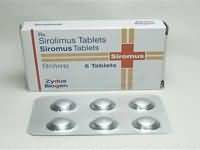CLINICAL USE
Immunosuppressant:Prophylaxis of transplant allograft rejection
DOSE IN NORMAL RENAL FUNCTION
6 mg loading dose followed by 2 mg daily, adjusted according to levels – see ‘Other Information’
PHARMACOKINETICS
DOSE IN RENAL IMPAIRMENT
GFR (mL/MIN)
DOSE IN PATIENTS UNDERGOING RENAL REPLACEMENT THERAPIES
IMPORTANT DRUG INTERACTIONS
Potentially hazardous interactions with other drugs
ADMINISTRATION
Reconstition
–
Route
Oral
Rate of Administration
–
Comments
–
OTHER INFORMATION
Aim for trough levels of 4–12 ng/mL where sirolimus is used in combination with low dose ciclosporinIn cases of delayed graft function or where a calcineurin inhibitor is not tolerated or contraindicated, sirolimus may be used with steroids alone. A loading dose of 10–15 mg may be given, followed by maintenance dose of 3–6 mg daily and adjust according to levels. Aim for trough levels of 8–20 ng/mLMay be used in combination with MMF, but can lead to delayed wound healing post surgery. Sirolimus can increase levels of mycophenolate mofetil leading to anaemiaSome centres successfully using level- controlled sirolimus in conjunction with low dose tacrolimus
Anecdotally, has been used for encapsulating sclerosing peritonitis in a CAPD patient at Guy’s Hospital, London. Acts by interfering with various growth factors and their effect on impairing wound healing.
Pneumonitis appears to be more common with sirolimus than initially thought, especially if the trough levels are on the high side.
If changing from tablets to solution, give the same dose and monitor trough levels 1–2 weeks laterTablet has a 27% increased bioavailability compared with the solutionSirolimus has been associated with anaphylactic/anaphylactoid reactions, angioedema and hypersensitivity vasculitis.

